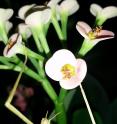Stick insects produce bacterial enzymes themselves
Many animals depend on their microbiome to digest their food. Symbiotic microorganisms produce enzymes their hosts cannot, and these work alone or together with the animals' own enzymes to break down their food. Many plant-feeding insects need microbial enzymes, such as pectinases, that degrade plant cell walls; yet some insects have overcome this dependency in a surprising way. Researchers at the Max Planck Institute for Chemical Ecology in Jena, Germany, found that stick insects make microbial enzymes themselves. From an ancestral gut microbe, the genes for the essential enzymes simply "jumped" as they are to their insect host. The researchers report this newly discovered "horizontal gene transfer" in a paper recently published in Scientific Reports. (Scientific Reports, May 2016, DOI: 10.1038/srep26388) "Insects are not supposed to make their own pectinases," explains Dr. Matan Shelomi, a postdoctoral fellow in the Department of Entomology and lead author of the study. Yet the stick insects make lots, and their genome contains multiple pectinase genes!" Based on DNA similarity, the source was a gamma-proteobactera, the most common bacteria type in the stick insect microbiome, but commonly found on the leaves they eat too. "We are not sure how it happened, but one or two pectinase genes from a gut bacterium or even just something in the food clearly jumped into the stick insect genome, and then evolved along with the insects," explains Shelomi. Tests show some of the new pectinases retained their original job degrading pectin, while others have yet unknown functions. But when did the transfer happen?
An international collaboration solves the puzzle
To find out, the team first tested seven different species of stick insect, including a primitive and short species found only in California called Timema cristinae, in the sister group to all the other stick insects. Timema do not have pectinases, while the others, the "Euphasmatodea," do. It was not clear, however, whether Timema never had the genes or simply lost them. The team then collaborated with the 1K Insect Transcriptome Evolution Project (1KITE). Using 1KITE's genetic databases from 1000 insect species, including nearly 50 Phasmatodea, the researchers could quickly search multiple groups for these enzymes. The results showed that the gene jump occurred sometime after Timema and Euphasmatodea split, but before the latter diverged into the 3000 or so species it has today: between 110 to 60 million years ago.
Gut microbe genes can change their hosts
Other researchers in the Department of Entomology previously discovered horizontal pectinase transfers in leaf beetles. It may not be a coincidence that these and the stick insects are all specialists on leaves. Nor is it necessarily coincidence that each group experienced a massive species radiation after their horizontal transfer occurred. "Something happened, to make the tiny Timema become a planet-wide group of nearly 3000 species that can be nearly half a meter long," says Shelomi, referring to the world's longest insect, a Euphasmatodea called Phoebetica chani. His new theory, the Enzyme Expansion Hypothesis, is that the sudden appearance of new enzyme abilities, either through mutation or horizontal gene transfer, can drive the evolution of a species and change their diets to specialize on a single food source.
Beyond enzymes, horizontal gene transfer can provide any number of new abilities, and our microbiome provides an immense source of potential species-altering proteins. "The idea that genes from microbes living in our guts can suddenly become part of our genomes and change the course of our evolutionary history, that's an incredible finding," Shelomi concludes. [MS/AO]
Source: Max Planck Institute for Chemical Ecology
Other sources
- Stick insects synthesize their own bacterial enzymesfrom UPITue, 31 May 2016, 21:31:02 UTC
- Stick insects produce bacterial enzymes themselvesfrom Science DailyTue, 31 May 2016, 17:00:58 UTC
- Stick insects produce bacterial enzymes themselvesfrom PhysorgTue, 31 May 2016, 16:01:22 UTC
